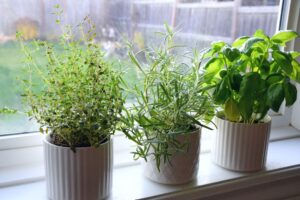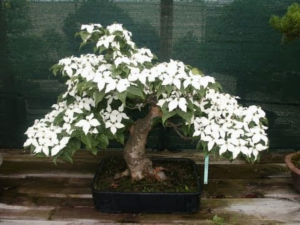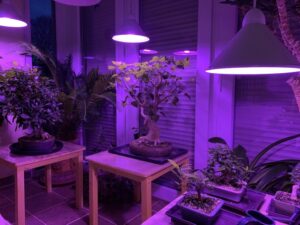Do you know the Ficus Benjamina bonsai tree is one of the easiest ones to care for? They don’t even have tremendous growing instructions! These bonsai trees are a perfect match for your house.
In this article, we will walk you through ficus benjamina bonsai care and how to make ficus benjamina bonsai. Without a further delay, let’s dive into it.
What is Ficus Benjamina?
The Ficus genus contains over 900 distinct species, which grow naturally in tropical climates, primarily in East Asia.
Ficus Benjamina Bonsai trees are evergreen, so they do not lose their leaves seasonally. Some Ficus species also yield the delectable figs found in supermarkets.
Ficus Benjamina bonsai tree is a lovely umbrella-like canopy made with thin branches that generally flow downward from the weight of the leaves, making it magnificent.
It is a hardy bonsai type that adapts well to shifting situations. These ficus benjamina bonsai have broad leaves that sprout from the plant’s upper stems, making them simple to prune.
Weeping figs grow to remarkable heights in the wild in Australia and Asia, but they’re slow growers who rarely overrun their house space. They’re sometimes available with spiral or braided trunks.
Ficus trees can reach a height of up to 100 feet in the wild. They do, however, grow well in miniature and make a lovely, one-of-a-kind houseplant.
Outdoor bonsai plants are a great way to add a touch of nature and beauty to your outdoor space. These miniature trees require special care and attention to thrive, but they offer many benefits, such as improving air quality and reducing stress. Popular outdoor bonsai plant species include the Japanese Maple, Pine, and Juniper. Enjoy the tranquility of nature with an outdoor bonsai plant.
Why is Ficus Benjamina Suitable for Beginners?
Growing Ficus Benjamina Bonsai tree is much easier than you might imagine. You don’t need to be experienced in gardening to grow your bonsai at home as it is beginner-friendly.
It is suitable for novices because it can quickly adjust to the environment.
- The essential feature of the Ficus Benjamina bonsai tree is its ability to adapt to its surroundings more quickly, specifically in shifting climatic conditions.
- You may grow this bonsai plant in any corner of the world with correct care. These bonsai prefer to be in the shadow. Therefore, growing them indoors will be an ideal choice.
- Ficus Benjamina plants develop at a higher rate than other bonsai plants. As a result, training them in any of the needed bonsai styles is simple.
- Ficus Benjamina bonsai tree is recommended for well-being and success in Vastu, feng shui, and other systems. Ficus plants are known to produce more oxygen.
- Ficus bonsai trees are beautiful works of art that can transform your home.
Ficus Benjamina Bonsai Styles
Ficus Benjamina can be trained and tended to in a variety of ways. It’s perfect for these looks. Here are Ficus Benjamina Bonsai Styles:
- Formal upright style (Chokkan):
The standard upright style is a very standard form for ficus benjamina Bonsai. This form usually happens in nature, specifically when the tree is openly getting tons of light and does not encounter the issue of competing trees. In this particular style, the tapering of the vertical-emerging trunk must be visible. Hence, the trunk should be wider at the base and must extend slimmer with the height.
- Informal upright style (Moyogi):
The trunk in this formation extends vertically in the form of a letter ‘S’ and at every turn, new branches appear. Tapering of the trunk should be visible in this style as well, with the bottom of the trunk denser than the higher part.
- Broom style (Hokidachi):
The trunk in this style is straight and upright and doesn’t have a similar growth pattern when they reach the top of the tree, the branches and foliage create a ball-shaped which is also a ravishing view during winter months.
- Cascade style (Kengai):
One of the most interesting shapes and is difficult to create as well. Cascade Bonsai are cultivated in tall containers. The tree should extend vertically for a short spread but then curve in a bowed formation. The peak of the tree usually extends beyond the edge of the container, but the subsequent branches on the outer curves of an S-shaped trunk.
- Semi-cascade style (Han-kengai):
The trunk extends upright for a short stretch and then curves sidewards. Unlike the cascade form, the semi-cascade trunk will never extend below the base of the pot.
- Clasped-to-rock (Seki-joju):
With Ficus Benjamina Bonsai the roots extend over a rock into the pot, so managing techniques for this bonsai style is different from tending for any other style.
- Rock-over-root style (Ishisuki):
In this style, the roots of the tree develop in the gaps of the rock. This indicates that there is not much space for the roots to evolve and absorb nutrients. Trees growing in rocks will never look healthy, so maintaining them is hard and needs expert-level knowledge.
How to Grow Ficus Benjamina Bonsai?
You can either grow your ficus Benjamina bonsai tree from the propagation or by purchasing the tree online and planting it. We will cover both techniques one by one.
Growing from a plant
- Plant in your ficus Benjamina bonsai tree in a deep, drainage-holed container that is slightly larger.
- Fill the space surrounding the plant with soil-based compost, plus a little perlite or vermiculite for drainage.
- Make sure you fill the pot with this medium up to two-thirds full.
- You should maintain the ficus Benjamina bonsai care by regularly placing it in partial sunlight and watering it.
- Avoid overwatering, as this might cause the plant to rot.
Note for ficus Benjamina bonsai care:
- You can keep the plant in the same pot for two years.
- When your Ficus Benjamina plant branches become longer, you can trim them.
- When touching a weeping fig, wear gloves since the sap can be irritating.
Propagation
Ficus Benjamina bonsai from cutting
A stem cutting from an established ficus is the simplest technique to start a new ficus. A little stem with green growth on top will be the greatest trimming.
Note: The stem doesn’t need to be brand new, but it shouldn’t be too old either. Look for a stem in the tree that hasn’t been damaged and has healthy green leaves.
- Now, you should remove the bottom leaves from the cutting.
- Trim all the leaves from the bottom of the cutting with scissors or garden shears.
- You can keep one top leaf but remove all others to allow the plant to focus its efforts on roots.
Note: If your cutting has many leaves, it will quickly dry out and perish since the plant will expend too much energy to keep the leaves alive. Remove most of the leaves.
- Place the cutting in a glass of cold water to cool.
- Fill it halfway with fresh water.
- Submerge the stem of the cutting in the glass, leaving the leaves above water.
- The cutting will begin to form roots while it sits in the water.
- Allow your cutting to receive plenty of light and freshwater.
- Once or twice a week, ficus Benjamina bonsai care includes changing the water in the glass.
- Place the glass in a warm, bright, and slightly humid environment.
- Filtered light is preferable for the propagation of the ficus.
Note for Ficus Benjamina bonsai care: Leave it for at least three weeks.
- Now, take a container to fill it halfway with a high-quality, well-draining, soil-based potting mix.
- Transfer the cutting to the pot after removing it from the water.
- Plant your cutting in a way that roots are firmly instilled.
- Ensure that ficus benjamina bonsai from cutting is held upright.
- Cover the roots and bottom of the stem with extra soil.
Note: Gently tap the pot against a flat surface a few times after adding the soil to help it settle around the roots.
- Ficus benjamina bonsai from cutting should be thoroughly watered.
- Place the newly transplanted ficus in a sunny, warm position away from direct sunlight, at least until it has established itself.
- Before the ficus benjamina bonsai from cutting is exposed to direct sunlight, it should have some new growth at the top.
Check Out: How to Grow Bonsai From Cutting
Propagation from seeds:
Growing bonsai from from seeds will take years, so normally people don’t go for that option, but you will have the advantage of shaping it from the very beginning if you start with seeds. Ficus seed works nicely when the seeds are relatively fresh as this will offer a higher germination rate. But since exclusively a plant or two are required even a batch of seeds with inadequate germination will let a plant or two to be evolved.
- Take a disposable container and fill it up with soil mix (half perlite and half peat moss and slow-release fertilizer). Pack the soil reasonably but not too hard.
- Set the seed into the container, but not too deep. Seeds need light and air for germination. Just keep them at a length where they are well connected with the soil, air, and light.
- Water the seeds very gently and get them to soak all the way through to keep them moist. Water them every day and if it’s drying quickly you can water them twice. But keep the soil moist, not saturated.
- Within a month or so if it gets a steady temperature, it will start to germinate.
- After germination, you can transplant the healthy seedlings into their new pot. Keep the same soil mix in order to not shock them.
Ficus Benjamina Bonsai tree Care
Location
Ficus Benjamina Bonsai care requires a lot of sunlight to thrive. You should let your bonsai receive 3-4 hours of indirect or direct sunshine daily. Because it requires a lot of moisture, keeping it in the kitchen is a good idea.
Note: Make sure not to place your bonsai in a dark, cold corner of the home where it won’t get any light.
Watering
Ficus benjamina bonsai tree requires a huge amount of sunlight; it requires more water than others. If not closely monitored, these trees can quickly dry out. If you don’t have a moisture meter, you can measure how dry the soil is using your finger. Another approach to check for the moisture is to feel the plant’s weight. If a plant is lighter than usual, it needs to be watered.
Note for Ficus benjamina bonsai care:
Ficus benjamina bonsai tree in their natural environment drop their leaves at the start of the dry season, making them extremely sensitive to fluctuations in moisture. Make sure you’re watering regularly.
Light
Keep your Ficus benjamina bonsai tree near a window, particularly when it’s young. Ficus Benjamina can tolerate a considerable amount of shade as it becomes older. However, it thrives in direct sunlight, and if your tree is left in low light for too long, you may notice leaves of the bonsai dropping!
Note for Ficus Benjamina bonsai care:
- An indoor grow lamp might help your bonsai stay beautiful and healthy if you don’t have access to a bright window.
- In the summer, avoid using a lot of air conditioning since ficus benjamina bonsai tree will suffer if the temperature inside falls below 70 degrees Fahrenheit.
Humidity
Ficus benjamina bonsai tree prefers high humidity because they are tropical natives. Leaves that are dry and withered might be caused by low relative humidity.
To control humidity levels in your house, consider utilizing a humidifier. Keep the soil around the base of your ficus benjamina bonsai tree moist and spritz the leaves now and then to keep them from drying out.
Fertilizing
The nutrients you offer in your fertilizer are essential to your ficus Benjamina bonsai tree. The nutrients in the soil will quickly wash away and need to be replaced with a decent fertilizer. Every week, give your ficus a well-balanced fertilizer. It will be able to expand more swiftly as a result of this. You can switch to fertilizer every other month in the fall.
Note for ficus benjamina bonsai care: Don’t fertilize the ficus benjamina bonsai tree during the winter season as they fall into dormancy.
Repotting
For the first few years, you should repot ficus benjamina bonsai tree every year to ensure it has sufficient support for rapid growth. You should remove up to 30% of the surface roots while repotting to encourage new growth. Ficus thrives in well-draining soils rich in sand and other arrogates.
Any bonsai tree needs to be repotted regularly, which is a multi-step process:
- You should remove your ficus benjamina bonsai tree from its present pot with care.
- Brush away the excess soil of your bonsai.
- Make sure you lose the area of compacted roots.
- You should trim away the excessive root growth.
- At last, make sure to fill the old or new container with fresh soil and relocate your ficus benjamina bonsai tree to its newly revitalized home.
Diseases
Ficus benjamina bonsai styles are susceptible to mistakes made during cultivation and insects and parasites. Here are the common diseases that can potentially harm your bonsai tree.
Falling leaves
It is normal for ficus trees to lose their leaves but make sure the loss isn’t harming your bonsai. If your ficus lost its leaves, ensure it is adequately watered and then topdress the pot.
Leaves turning yellow
A mite infestation is to blame. Simply use an organic mite killer that can be found at online stores. You should avoid other chemical products, especially for an indoor plant.
White blisters
On the leaves of ficus benjamina bonsai tree, you can witness white blisters, and they are quite sticky. Mealybugs or scale insects are typically the reason.
Whiteflies
Ficus benjamina bonsai care includes showering your ficus in the bathroom. If you can’t readily move your ficus, spray the leaves with water once or twice a day until the whiteflies are gone.
Ficus Benjamina Pruning
The main reasons for ficus benjamina bonsai pruning are improving its shape and stopping it from growing. The classic indoor ficus has an exposed stem and a leafy crown shaped like a bush. Although the ficus may be easily conditioned and trimmed into this shape, it is not entirely natural. People who grow their ficus indoors emphasize and amplify more on its appealing aesthetic.
After new growth ends in the late summer and early fall, ficus benjamina bonsai pruning is vital. New growth is seen in the typical plant during the spring and early summer months. If you’re bringing a potted ficus inside for the winter, ficus benjamina bonsai pruning is a good idea.
Note for ficus benjamina bonsai care:
- Ficus trees are sturdy and tenacious. You can prune them during any time of year, not only during the summer and fall.
- You can prune your ficus’s dead or broken branches at any time of the year.
- Ficus benjamina bonsai pruning requires a pair of small pruning shears made for fine/close work. For the best outcomes, these should be neat and precise.
Ficus benjamina bonsai pruning should be performed in the following manner, step by step:
- Find a node where a leaf or twig connects to the stem or branch.
- You should cut on a modest downward slant before it.
- Make sure you cut close enough to the node without causing harm to it.
- Leave at least one node on that stem for further growth on the ficus bonsai tree.
- Cut a branch back to just before the trunk, and don’t leave any nodes if you want to get rid of it.
Note for ficus benjamina bonsai care: You should prune your bonsai in a way that looks natural and appealing.
FAQs:
Is Ficus Benjamin good for bonsai?
Ficus Benjamina, or Weeping Fig, is quite favored for bonsai because of the stunning umbrella-like top that can be created with the thin stems that naturally cascade in bowed formation from the weight of the leaves.
Can Ficus Benjamina bonsai grow indoors?
The Ficus genus belongs to the lineage of mulberry plants, and it’s the most favored indoor tree species and ideal for those who are just starting with bonsai practice. They are grown on every continent in tropical areas and are fitted for indoor Bonsai.
Conclusion
Ficus benjamina bonsai tree is a delight in any bonsai garden for both professional and novice bonsai growers.
Your bonsai will be a source of enjoyment and creativity in your life as well as a statement piece in your house if you treat it with care.
Ficus benjamina bonsai styles, on the other hand, are a fantastic choice if you’re just getting started with bonsai.
What are your thoughts on the bonsai Ficus benjamina? When are you planning to buy yours?
Related Articles
- Bonsai, Cake and a Meaningful Gift for Birthday
- 9 Herbs To Grow Indoors All Year Round
- Needles Drying Out On Juniper Bonsai- Causes, Signs, and Treatment.
- How To Grow And Care For Dogwood Bonsai
- All About Grow Light- Best Grow Lights For Your Bonsai In 2024
- White spots on the leaves?- Powdery mildew on bonsai (identification and solution).





